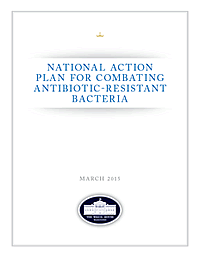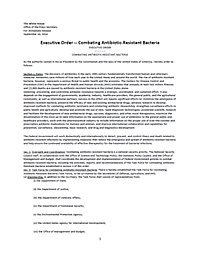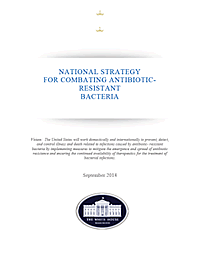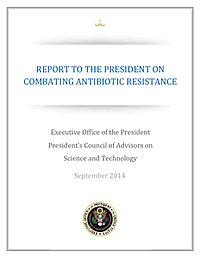Federal Engagement in Antimicrobial Resistance
The following is a brief overview of recent Federal efforts related to antibiotic resistance (AR) and CDC’s role in supporting these AR initiatives.
- White House Forum on Antibiotic Stewardship
- National Action Plan for Combating Antibiotic-Resistant Bacteria
- Executive Order – Combating Antibiotic-Resistant Bacteria
- National Strategy to Combat Antibiotic-Resistant Bacteria
- PCAST Report on Combating Antimicrobial Resistance
- CDC report: Antibiotic Resistance Threats in the United States, 2013
Federal Engagement in Antimicrobial Resistance
CDC funds 34 innovative projects to combat antibiotic resistance
CDC awarded more than $14 million to fund new approaches to combat antibiotic resistance, including research on how microorganisms naturally present in the human body (referred to as a person’s microbiome) can be used to predict and prevent infections caused by drug-resistant organisms. The awards, made through CDC’s Broad Agency Announcement (BAA), support activities in the CDC’s Antibiotic Resistance Solutions Initiative. The initiative, which also provides funding for state health departments and other partners, implements the tracking, prevention, and antibiotic stewardship activities outlined in the National Action Plan for the Combating Antibiotic-Resistant Bacteria [63 pages].
Read the CDC Press Release to learn more.
CDC funding accelerates antibiotic resistance efforts
CDC provided $67 million to help health departments nationwide tackle antibiotic resistance and other patient safety threats, including healthcare-associated infections. The new funding for antibiotic resistance, part of the awards available through CDC’s Epidemiology and Laboratory Capacity for Infectious Diseases Cooperative Agreement (ELC), also supports seven new regional laboratories with specialized capabilities allowing rapid detection and identification of emerging antibiotic resistant threats.
These funds will be distributed to all 50 state health departments, six local health departments (Chicago, the District of Columbia, Houston, Los Angeles County, New York City and Philadelphia), and Puerto Rico. The awards support activities related to CDC’s Antibiotic Resistance Solutions Initiative and implementation of the surveillance, prevention, and stewardship activities outlined in the National Action Plan for the Combating Antibiotic-Resistant Bacteria [63 pages].
Read the CDC media statement to learn more.
CDC Awards $26 Million to Academic Medical Centers, Drives Innovation to Protect Patients
CDC awarded $26 million to support applied research at five academic medical centers as part of a patient safety effort known as Prevention Epicenters Program. Together with CDC, these Prevention Epicenters develop and test innovative approaches to preventing infections and improving patient safety in healthcare settings. The new funding more than doubles previous awards and expands and extends the Prevention Epicenters program to 2020.
Read the CDC press release to learn more.
White House Forum on Antibiotic Stewardship
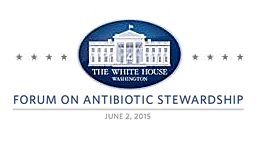 On June 2, 2015, the White House hosted the Forum on Antibiotic Stewardship to bring together more than 100 key human and animal health leaders involved in antibiotic stewardship—the development, promotion, and implementation of activities to promote optimal use of antibiotics nationwide. The leaders represented hospitals and healthcare systems, human and animal health, diagnostic and diagnostic pharmaceutical companies, agriculture organizations, and more who committed to taking part in antibiotic stewardship to change the way antibiotics are currently prescribed and used to slow the spread of drug-resistant infections.
On June 2, 2015, the White House hosted the Forum on Antibiotic Stewardship to bring together more than 100 key human and animal health leaders involved in antibiotic stewardship—the development, promotion, and implementation of activities to promote optimal use of antibiotics nationwide. The leaders represented hospitals and healthcare systems, human and animal health, diagnostic and diagnostic pharmaceutical companies, agriculture organizations, and more who committed to taking part in antibiotic stewardship to change the way antibiotics are currently prescribed and used to slow the spread of drug-resistant infections.
Read how organizations have committed to improving antibiotic stewardship.
Some examples of the stewardship commitments include:
- CDC, along with other Health and Human Services (HHS) agencies, will provide data about antibiotic use and prescribing trends in order to improve antibiotic use in the future and cut inappropriate prescribing by 50 percent in doctors’ offices and 20 percent in hospitals.
- Healthcare systems representing thousands of hospitals, long-term acute care facilities, and skilled nursing centers are committing to establishing or expanding stewardship programs [PDF – 986 KB] across their locations to improve prescribing.
- Major food producers are committing to phasing out giving unnecessary antibiotics to animals, and food retailers, like grocery stores, are committing to providing more antibiotic-free options to their consumers.
- Drug store and drug companies are committing to integrating CDC’s stewardship principles into programs that provide free or reduced-price antibiotics to patients.
For additional information about the White House Forum, see the resources listed below:
- White House Statement [ 10 pages]
- Event factsheet listing commitments from each of the participating organizations [10 pages]
- An op-ed from Tom Frieden, MD, MPH, Director, CDC
- CDC feature story on improving antibiotic use
A full description of how, if fully funded, CDC’s FY16 budget plans to support stewardship activities and the National Action Plan can be found in the Antibiotic Resistance Solutions Initiative.
National Action Plan for Combating Antibiotic-Resistant Bacteria [63 pages]
The White House released the National Action Plan for Combating Antibiotic Resistant Bacteria, which outlines steps for implementing the National Strategy and addressing policy recommendations of the President’s Council of Advisors on Science and Technology (PCAST) report on combating antibiotic resistance.
The National Action Plan outlines federal activities over the next five years to:
- Enhance domestic and international capacity to prevent and contain outbreaks of antibiotic-resistant infections
- Maintain the efficacy of current and new antibiotics
- Develop and deploy next-generation diagnostics, antibiotics, vaccines, and other therapeutics
Read an interview with President Obama and WebMD about the National Action Plan to Combat Antibiotic Resistant Bacteria.
Read the White House Blog Post by Secretaries Burwell, Carter, and Vilsack on this important topic.
Executive Order – Combating Antibiotic-Resistant Bacteria [6 pages]
The President released an Executive Order to emphasize the importance of addressing the threat of antimicrobial resistance. The Executive Order included specific actions related to:
- Policy and the government’s role to detect, prevent, and control illness and death related to AR by implementing measures to reduce its spread
- Establishing a task force for combating antibiotic-resistant bacteria, which would be co-chaired by the Secretaries of Defense, Agriculture, and Health and Human Services Department (HHS)
- Developing a five-year National Action Plan to outline specific actions to be taken to implement the National Strategy and updates to the Action Plan in years thereafter
- Establishing the Presidential Advisory Council on Combating Antibiotic-Resistant Bacteria
- Improving antibiotic stewardship and use of antibiotics by hospitals and other inpatient healthcare delivery facilities
- Strengthening national surveillance systems and laboratory networks of resistant bacteria
- Preventing and responding to infections and outbreaks of antibiotic-resistant bacteria
- Promoting new and next-generation antibiotics and diagnostics
- Supporting cooperation of international antibiotic resistance efforts
» Learn more [5 pages] about the Executive Order.
National Strategy to Combat Antibiotic-Resistant Bacteria [37 pages]
The White House released the National Strategy for Combating Antibiotic-Resistant Bacteria to prevent, detect, and control illness and death related to antibiotic-resistant infections. To support the National Strategy, CDC is working to address the threat of antibiotic-resistant bacteria in four key areas:
- Slow the development of resistant bacteria and prevent the spread of resistant infections.
- Strengthen national one-health surveillance efforts to combat resistance.
- Advance development and use of rapid and innovative diagnostic tests for identification and characterization of resistant bacteria.
- Improve international collaboration and capacities for antibiotic resistance prevention, surveillance, control and antibiotic research and development.
PCAST Report on Combating Antimicrobial Resistance [PDF – 78 pages]
The President’s Council of Advisors on Science and Technology (PCAST) released its report to the President on Combating Antimicrobial Resistance in the U.S. with key recommendations focusing on antibiotic resistance policy, stewardship, and surveillance. The PCAST’s recommendations to curb antibiotic resistance include three key areas:
- Improving surveillance of the antibiotic-resistant bacteria
- Increasing longevity of current antibiotics by improving use and implementation of interventions
- Increasing the rate at which new antibiotics and other interventions are discovered and developed
» Learn more [2-pages] about the PCAST Report.
CDC report: Antibiotic Resistance Threats in the United States, 2013
 CDC released its report, Antimicrobial resistance threats in the U.S., and sounded the alarm to drug-resistant bacteria. The report, the first to look at burden and threats posed by AR on human health, shows:
CDC released its report, Antimicrobial resistance threats in the U.S., and sounded the alarm to drug-resistant bacteria. The report, the first to look at burden and threats posed by AR on human health, shows:
- More than two million people are sickened every year with antibiotic-resistant infections, with at least 23,000 dying as a result
- Antibiotic-resistant bacteria prioritized by threat-level: urgent, serious, or concerning
- Core initiatives taken by CDC to fight the spread of antibiotic resistance
- Summaries of resistant bacteria, including key actions that public health professionals, health providers, and patients can take to combat antibiotic resistance
- Page last reviewed: February 2, 2017
- Page last updated: April 10, 2017
- Content source:


 ShareCompartir
ShareCompartir
